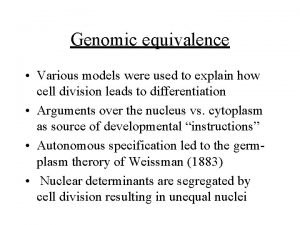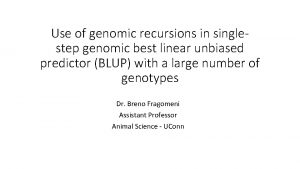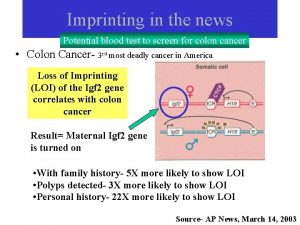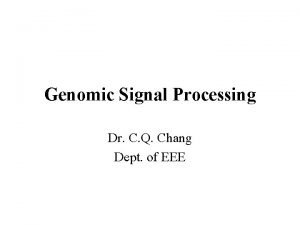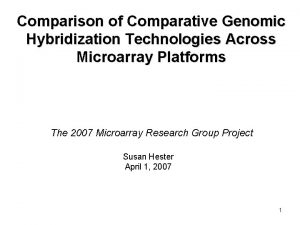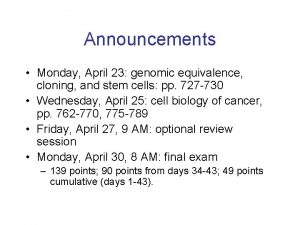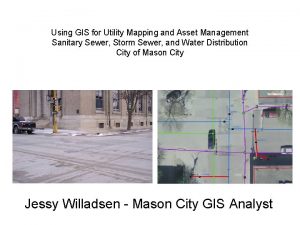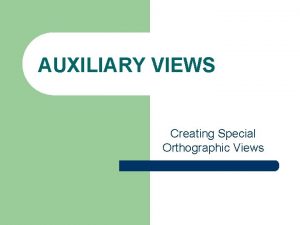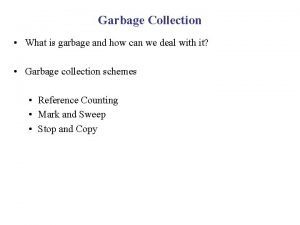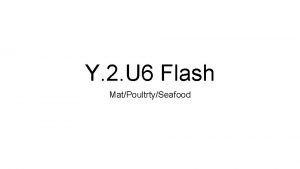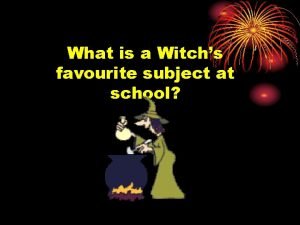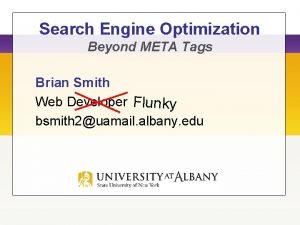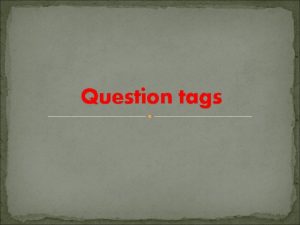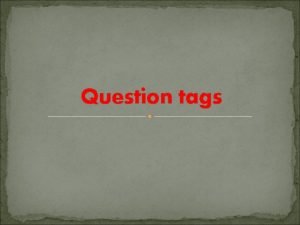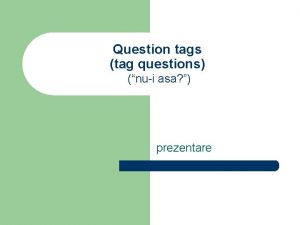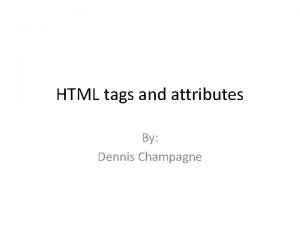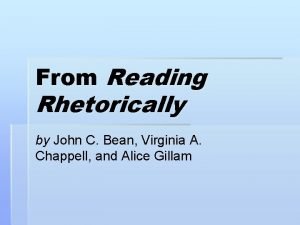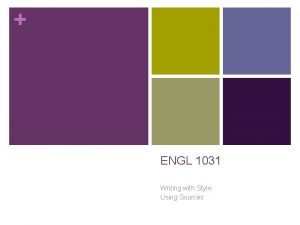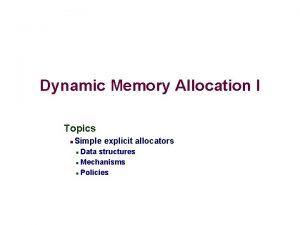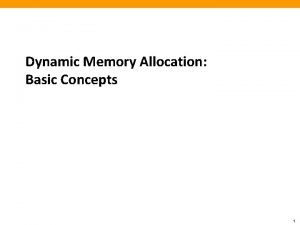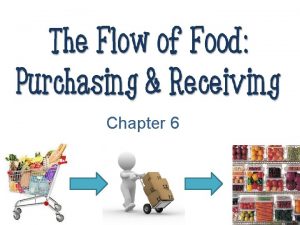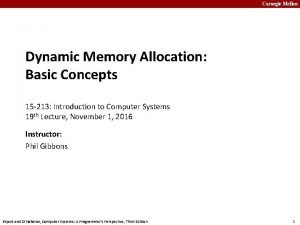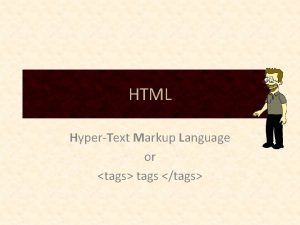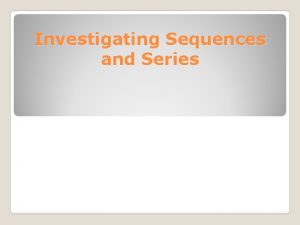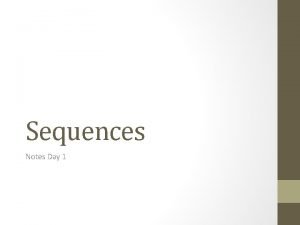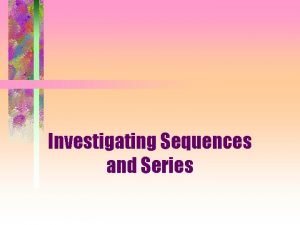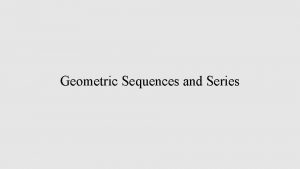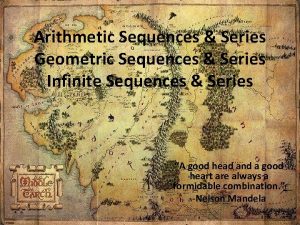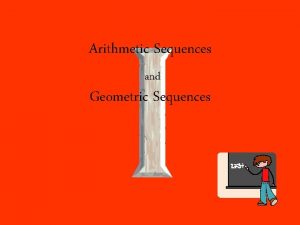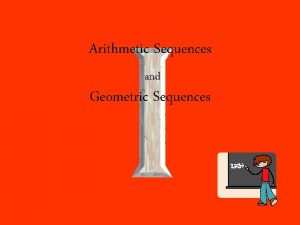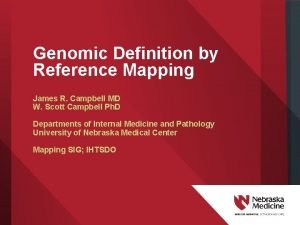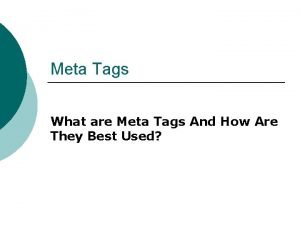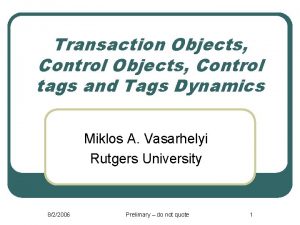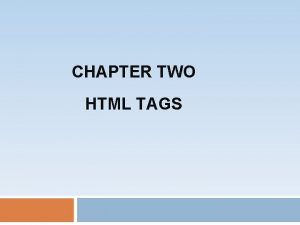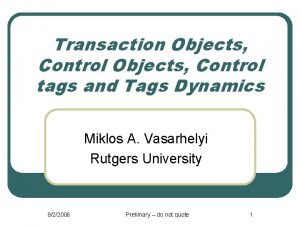Mapping Genomic Sequences Using Optical Reference Tags ACGT































![Dynamic programming • The optimal solution is found using DP. • T[i, j] = Dynamic programming • The optimal solution is found using DP. • T[i, j] =](https://slidetodoc.com/presentation_image_h2/2bb0b7777a8298e0bca80d01c795dd9b/image-32.jpg)
![Running time • T[n, m] requires O(n 2 m 2) running time, where n Running time • T[n, m] requires O(n 2 m 2) running time, where n](https://slidetodoc.com/presentation_image_h2/2bb0b7777a8298e0bca80d01c795dd9b/image-33.jpg)


















- Slides: 51

Mapping Genomic Sequences Using Optical Reference Tags ACGT team meeting 17 th Oct, 2012 Yaron Orenstein and Omer Zuqert

Talk overview 1. Introduction: technology. 2. Mathematical formalization of the problem. 3. Solution: dynamic programming. 4. Results. 5. Summary.

INTRODUCTION

Presentation based on two papers 1. Genomics via Optical Mapping IV: Sequence Validation via Optical Map Matching Marco Antoniotti, Thomas Anantharaman, Salvatore Paxia, Bud Mishra NYU, Technical report, 2001 2. Genome Mapping on Nanochannel Arrays for Structural Variation Analysis and Sequence Assembly Ernest T Lam, Alex Hastie, Chin Lin, Dean Ehrlich, Somes K Das, Michael D Austin, Paru Deshpande, Han Cao, Niranjan Nagarajan, Ming Xiao & Pui. Yan Kwok University of California, Nature Biotechnology, 2012

Optical genome mapping • DNA sequences are cut to fragments using restriction enzymes. • These fragments are attached to a glass (in an electric field), and their length is measured. • Using the lengths and the known restriction site, mapping to the genome is possible.

Microscopic image • Before and after enzyme digestion. (Jing et al. , PNAS 98)

Noise in optical mapping • DNA sequences are not completely stretched. • Enzymes can miss a restriction site, or cut in a new site. • Orientation is unknown. • Thus, requires aggregation for reliable results.

New optical mapping • DNA molecules run through a microfluidic channel (thus, less wiggle). • Use multiple florescent enzymes to tag sites. • Color to measure AT-content in 1000 bp windows.

Nonachannels illustrations • A gradient region is in front of the nanochannels. The molecules are forced to flow by the pillars (Lam et al. , NBT 2012).

Microscopic image • A mixture of nick-labeled DNA molecules in the nanoarray (73× 73μm). Up to 1 Mb of a DNA molecule from top to bottom. (Lam et al. , NBT 2012)

Applications • Filling the gaps of next-generation sequencing: – Constructing repetitive segments. – Finding sequence errors / single site variability. • Measuring structural variation (without sequencing). • Locating epigenetic marks (DNA methylation and nucleosomes positioning).

Example of Lam et al. , NBT 2012 • MHC are cell surface molecules that mediate interactions of white blood cells. • MHC genomic region us 4. 7 MB long. • Examples shown on 49 and 46 BAC clones from two individuals (PGF and COX, respectively).

Lengths and maps (b) The distribution of the DNA molecules imaged on the nanoarray by length. (c) Three overlapping consensus maps (each ~150 kb long) are assembled into a 300 -kb map.

Single site variation PGF genome (blue line) contains an extra Nt. Bsp. QI site not found in the COX genome (red line) with the maps generated by genome mapping showing the expected pattern. (Lam et al. , NBT 2012)

Shifting of a site • The 21 -kb region is split into 12 - and 9 -kb fragments in the COX genome (red line) but 14 - and 7 -kb fragments in the PGF genome (blue line). (Lam et al. , NBT 2012)

Insertions identification • The PGF genome has a 5 -kb insertion that also includes an Nt. Bsp. QI site (blue line) when compared to the COX genome (red line). (Lam et al. , NBT 2012)

Duplication • A 30 -kb duplication at the RCCX locus is identified and localized in both the reference map (gray line) and that produced by genome mapping (blue histogram plot). (Lam et al. , NBT 2012)

Yuval Ebenstein’s lab • Goal: use minimum number of fluorescence tags to accurately map genomic sequences. • Aim: measure disease-causing structural variability in the telomere part of the genome. • Additional (free) information: AT-content averages in 1000 bp resolution.

Ebenstein’s lab webpage

MATHEMATICAL FORMALIZATION

Problem definition • Input: a vector of lengths, representing length in base pairs between fluorescence tags. • Output: chromosome number of the DNA molecule. • Parameters: false positive and false negative rates of fluorescence tags, standard deviation of the stretch factor.

Consensus and sequence maps • A consensus optical map is an ordered restriction map, represented as a vector of fragments: <ci, li, σi>. • ci = cut probability, li = mean length, σi = std of length variable (strech factor). • A sequence map is an in silico ordered map.

A simple matching (Antoniotti et al. , Technical report, 01)

Objective function • The probability for a consensus map is: • Taking the logarithm: • Minimizing “weighted sum-of-squares”:

False cuts and missing cuts • Probability for a no-missing restriction site: pc. pc=1 means all sites are present in the map. • Probability for a false restriction site: pf. pf=0 means there are no false cuts.

Cuts illustration (Antoniotti et al. , Technical report, 00)

SOLUTION

Case 1: no missing cuts and no false cuts • The probability of the i-th segment is: • After negative logarithm:

Case 2: Missing cuts and no false cuts • The term for a missing cut is: • After negative logarithm:

Case 3: no missing cut and some false cuts • Aggregate fragments i and i-1 of the consensus against the i-th fragment of the sequence map: • After negative logarithm:

Case 4: putting it all together
![Dynamic programming The optimal solution is found using DP Ti j Dynamic programming • The optimal solution is found using DP. • T[i, j] =](https://slidetodoc.com/presentation_image_h2/2bb0b7777a8298e0bca80d01c795dd9b/image-32.jpg)
Dynamic programming • The optimal solution is found using DP. • T[i, j] = log probability of matching i fragments in the sequence map and j in the consensus =
![Running time Tn m requires On 2 m 2 running time where n Running time • T[n, m] requires O(n 2 m 2) running time, where n](https://slidetodoc.com/presentation_image_h2/2bb0b7777a8298e0bca80d01c795dd9b/image-33.jpg)
Running time • T[n, m] requires O(n 2 m 2) running time, where n and m = #fragments in the sequence and consensus maps, respectively. • Practically, u and v are bounded by 3, reducing the running time to O(nm).

Adding AT-content information • In each step of the DP, some fragments are matched. • The AT-content average is known experimentally and in silico. • We suggest adding a score for the difference in average AT-content.

Using several florescence tags • The input here is a vector of lengths, separated by colors. • A match is possible for the same color only. • Note that a swapping between adjacent colors is possible (each color filmed separately).

RESULTS

Simulation goals • Finding the minimal length of a DNA fragment that can be identified with high certainty. • Finding enzymes that minimize the number of fluorescence tags and the required length. • Measure parameters effect on accuracy to achieve better experimental design.

Simulation - Data Preprocessing • The human genome downloaded from UCSC. • From each chromosome, first and last 1 Mbps (two chromosome arms) were extracted. • Arms with insufficient data (more than 50% N in the published sequence) were removed.

Simulation – Modeling • Given a reference sequence, an optical map is generated using the following parameters: • pc = true cut probability = 0. 79. • pf = false cut probability = 5× 10 -6 per bp. • σ = sizing error = 1000 bp. • Optical resolution = 1800 bp.

Simulation • Reference maps built from reference sequences. • For each sequence 100 optical maps are generated; each map is aligned against all reference maps to find the best match. • Repeated for different length in the range 25 Kbp – 1 Mbp (25 Kbp interval).

Simulation - results • For each length, results presented in a matrix. • Mij – # times that the optical map generated from the ith arm was best aligned to the reference map corresponding to the jth arm. • Red = 100, blue = 0.

1 Mbp, Bspq. I &Bse. CI chr. X chr 2 chr 1 chr 1 chr 1 chr 1 chr 1 chr 9 chr 8 chr 7 chr 6 chr 5 chr 4 chr 3 chr 2 chr 1 q 2 q 1 q 0 q 0 p 9 q 9 p 8 q 8 p 7 q 7 p 6 q 6 p 5 q 4 q 3 q 2 q 2 p 1 q 1 p 0 q 0 p q p q p q p 0 0 0 0 0 0 0 0 0 0 100 chr 1 p 0 0 0 0 0 0 0 0 0 0 100 0 chr 1 q 0 0 0 0 0 0 0 0 0 0 100 0 0 chr 2 p 0 0 0 0 0 0 0 0 0 100 0 chr 2 q 0 0 0 0 0 0 0 0 0 100 0 0 chr 3 p 0 0 0 0 0 0 0 0 0 100 0 0 chr 3 q 0 0 0 0 0 0 0 0 0 100 0 0 0 chr 4 p 0 0 0 0 0 0 0 0 99 0 1 0 0 0 chr 4 q 0 0 0 0 0 0 0 0 100 0 0 0 0 chr 5 p 0 0 0 0 0 0 0 0 100 0 0 0 0 chr 5 q 0 0 0 0 0 0 0 0 100 0 0 chr 6 p 0 0 0 0 0 0 0 100 0 0 chr 6 q 0 0 0 0 0 0 0 100 0 0 0 chr 7 p 0 0 0 0 0 0 0 100 0 0 0 chr 7 q 0 0 0 0 0 0 0 100 0 0 0 chr 8 p 0 0 2 0 0 0 0 4 0 0 0 85 2 0 0 0 0 0 7 0 0 0 chr 8 q 0 0 0 0 0 0 100 0 0 0 0 chr 9 p 0 0 0 0 0 0 99 0 0 1 0 0 0 0 chr 9 q 0 0 0 0 0 0 100 0 0 0 0 chr 10 p 0 0 0 0 0 100 0 0 0 0 chr 10 q 0 0 0 0 0 99 0 0 0 0 1 0 0 0 chr 11 p 0 0 0 0 0 100 0 0 0 0 0 chr 11 q 0 0 0 0 0 100 0 0 0 0 0 chr 12 p 0 0 0 0 100 0 0 0 0 0 chr 12 q 0 0 0 0 100 0 0 0 0 0 0 chr 13 q 0 0 0 0 100 0 0 0 0 0 0 chr 14 q 0 0 0 0 100 0 0 0 0 0 0 chr 15 q 0 0 0 100 0 0 0 0 0 0 chr 16 p 0 0 0 100 0 0 0 0 0 0 0 chr 16 q 0 0 0 0 0 100 0 0 0 0 0 0 0 chr 17 p 0 0 0 0 0 100 0 0 0 0 0 0 0 chr 17 q 0 0 0 0 100 0 0 0 0 0 0 0 chr 18 p 0 0 0 0 100 0 0 0 0 0 0 0 0 chr 18 q 0 0 0 100 0 0 0 0 0 0 0 0 chr 19 p 0 0 0 100 0 0 0 0 0 0 0 0 chr 19 q 0 0 100 0 0 0 0 0 0 0 0 chr 20 p 0 0 0 100 0 0 0 0 0 0 0 0 0 chr 20 q 0 0 100 0 0 0 0 0 0 0 0 0 chr 21 q 0 100 0 0 0 0 0 0 0 0 0 chr 22 q 100 0 0 0 0 0 0 0 0 0 chr. Xq

700 Kbp, Bspq. I &Bse. CI chr. X chr 2 chr 1 chr 1 chr 1 chr 1 chr 1 chr 9 chr 8 chr 7 chr 6 chr 5 chr 4 chr 3 chr 2 chr 1 q 2 q 1 q 0 q 0 p 9 q 9 p 8 q 8 p 7 q 7 p 6 q 6 p 5 q 4 q 3 q 2 q 2 p 1 q 1 p 0 q 0 p q p q p q p 0 0 0 0 0 0 0 0 0 0 100 chr 1 p 0 0 0 0 0 0 0 0 0 0 100 0 chr 1 q 0 0 0 0 0 1 0 0 0 0 0 1 97 0 0 chr 2 p 0 0 0 1 0 0 0 0 0 0 99 0 0 0 chr 2 q 0 0 1 0 1 0 0 0 1 0 0 0 0 1 0 0 0 92 1 1 0 0 chr 3 p 0 0 0 2 0 0 1 0 0 0 2 0 0 0 0 0 1 0 2 0 0 0 0 91 0 0 0 chr 3 q 0 0 1 0 0 0 0 0 0 0 0 99 0 0 0 chr 4 p 1 0 1 3 0 0 0 1 1 0 0 0 3 0 1 1 0 0 0 1 81 0 1 1 0 0 chr 4 q 0 0 0 0 1 0 0 0 95 0 0 1 0 0 0 chr 5 p 0 0 0 0 0 3 0 0 0 94 0 0 2 0 0 1 0 0 0 chr 5 q 0 0 0 0 0 1 0 0 0 2 0 5 0 0 0 0 0 1 89 0 1 0 0 0 1 0 chr 6 p 0 0 0 0 1 0 0 0 99 0 0 0 chr 6 q 0 0 1 0 0 0 0 1 96 0 0 0 chr 7 p 0 0 0 1 0 0 0 0 96 0 0 0 0 1 0 0 0 chr 7 q 0 0 0 0 3 0 0 0 0 0 1 0 1 1 0 84 0 1 0 0 0 5 0 1 0 0 2 0 0 0 chr 8 p 0 1 0 0 0 0 0 2 0 0 0 1 0 84 1 0 5 0 0 0 1 1 1 0 chr 8 q 0 0 0 2 1 0 0 0 94 0 0 0 1 0 0 0 0 0 chr 9 p 0 0 2 0 0 0 0 1 1 8 0 0 0 68 0 0 4 1 1 0 2 1 6 0 0 0 1 3 0 0 0 chr 9 q 0 0 0 1 0 0 0 1 0 1 91 1 0 0 0 0 2 1 0 0 0 0 chr 10 p 0 0 0 1 0 0 0 0 92 0 0 1 1 0 0 0 1 0 1 0 0 0 chr 10 q 0 1 0 0 0 2 86 1 0 0 2 0 0 0 0 0 2 1 0 0 chr 11 p 0 0 0 0 1 0 98 0 0 0 0 0 0 chr 11 q 0 0 1 0 0 0 0 98 1 0 0 0 0 0 0 chr 12 p 0 0 0 0 96 0 1 0 0 0 2 1 0 0 0 0 chr 12 q 0 0 0 0 0 1 0 0 99 0 0 0 0 0 0 chr 13 q 0 0 0 1 0 0 0 0 0 97 0 0 0 0 1 0 0 0 0 chr 14 q 0 0 0 0 1 0 0 0 92 0 0 1 0 2 0 0 0 0 0 1 0 0 2 0 0 0 chr 15 q 0 0 0 0 0 1 0 0 97 0 0 0 0 0 1 0 0 0 0 chr 16 p 0 0 0 95 0 0 0 0 1 0 0 2 1 0 0 0 chr 16 q 0 0 0 0 0 100 0 0 0 0 0 0 0 chr 17 p 0 0 0 0 0 90 0 0 0 0 4 0 0 0 1 0 0 2 1 0 0 0 2 0 0 0 chr 17 q 0 0 0 0 99 0 0 0 0 0 1 0 0 0 0 0 chr 18 p 0 0 0 1 2 0 0 82 0 0 0 0 0 1 4 0 0 1 0 4 0 1 0 1 0 0 2 0 0 0 chr 18 q 0 0 0 2 1 0 94 0 0 0 1 0 0 0 0 0 0 0 chr 19 p 0 0 0 99 0 0 0 0 0 0 0 0 1 0 0 0 chr 19 q 0 0 0 1 96 0 0 0 1 0 0 0 0 0 0 0 chr 20 p 0 0 0 90 0 0 0 1 0 0 5 0 0 0 1 0 1 0 0 0 chr 20 q 0 0 93 0 0 0 0 2 0 0 0 1 1 0 0 0 2 0 0 0 1 0 0 chr 21 q 0 82 0 2 1 0 0 0 1 1 1 0 0 2 0 1 0 0 0 1 2 0 0 0 chr 22 q 96 0 0 0 0 1 0 0 0 0 0 0 1 0 0 0 1 1 0 0 chr. Xq

400 Kbp, Bspq. I &Bse. CI chr. X chr 2 chr 1 chr 1 chr 1 chr 1 chr 1 chr 9 chr 8 chr 7 chr 6 chr 5 chr 4 chr 3 chr 2 chr 1 q 2 q 1 q 0 q 0 p 9 q 9 p 8 q 8 p 7 q 7 p 6 q 6 p 5 q 4 q 3 q 2 q 2 p 1 q 1 p 0 q 0 p q p q p q p 1 0 0 0 0 2 0 1 0 0 2 0 0 0 1 1 0 0 0 0 0 90 chr 1 p 0 0 0 0 0 9 0 0 0 0 0 0 0 91 0 chr 1 q 0 0 0 1 2 0 3 1 1 1 0 0 0 1 0 9 0 1 0 3 0 5 2 1 3 1 0 0 5 0 1 1 0 1 57 0 0 chr 2 p 0 0 1 0 1 0 2 1 0 1 1 1 0 0 2 3 2 0 3 0 0 2 3 0 0 0 4 1 1 1 0 0 65 0 1 2 chr 2 q 0 0 1 2 3 3 2 2 1 4 4 0 2 0 7 1 4 0 2 0 2 4 5 0 3 2 0 3 1 2 0 27 1 5 1 1 chr 3 p 0 2 4 0 2 2 0 0 0 2 0 0 1 0 0 0 3 2 4 3 2 1 0 1 49 0 1 2 0 1 chr 3 q 1 0 0 2 1 0 2 4 1 1 0 0 1 1 2 0 0 2 1 2 3 1 1 0 0 2 2 2 0 1 2 63 0 0 0 1 0 0 chr 4 p 1 2 3 4 1 1 1 0 1 1 1 5 2 2 1 4 1 5 4 5 2 1 4 3 1 4 2 1 1 1 0 4 21 2 0 2 2 1 chr 4 q 0 1 1 2 1 0 0 1 1 2 2 3 0 0 1 0 8 0 1 0 4 0 1 3 2 4 1 1 1 53 2 2 1 0 0 0 chr 5 p 0 0 10 0 2 0 6 0 0 1 1 9 0 1 0 5 6 1 0 3 3 41 1 1 0 3 1 0 1 chr 5 q 0 1 1 3 1 0 0 6 0 4 0 9 1 2 1 0 5 0 9 1 1 1 6 2 2 3 1 1 2 21 0 2 2 0 3 0 7 1 1 0 chr 6 p 3 1 1 2 2 0 1 0 0 0 0 4 1 0 0 2 0 1 0 0 5 1 2 54 1 2 7 2 0 0 1 1 1 2 2 chr 6 q 1 0 0 0 2 0 0 0 1 1 1 0 0 0 0 1 0 0 0 2 0 0 0 80 8 1 0 0 0 chr 7 p 0 0 6 1 1 0 0 4 0 3 0 4 0 2 0 0 0 4 6 0 0 0 2 5 4 5 27 5 0 1 1 4 2 0 5 0 3 3 2 0 chr 7 q 0 0 0 4 0 0 0 3 0 6 0 4 2 0 1 0 3 1 4 0 0 0 2 1 4 39 1 1 1 3 10 4 0 0 2 2 1 1 chr 8 p 2 0 2 2 0 3 0 2 0 0 0 1 0 3 0 1 2 1 1 0 3 3 0 1 35 9 5 7 1 0 2 2 2 1 2 0 4 3 0 0 chr 8 q 0 2 4 3 3 0 1 1 0 0 0 7 1 0 0 0 2 0 0 0 3 44 3 0 0 3 1 1 1 5 3 1 4 2 1 1 1 0 chr 9 p 0 0 3 0 0 5 0 4 0 6 0 5 0 0 3 2 6 1 2 0 31 3 1 6 1 2 1 0 1 3 0 4 1 1 6 2 0 0 chr 9 q 2 0 1 2 1 0 1 1 0 0 2 1 1 0 1 5 3 0 3 47 2 0 4 0 1 6 2 1 3 4 1 0 1 1 0 0 chr 10 p 0 0 1 3 2 0 1 1 0 11 2 2 3 0 0 1 1 0 40 0 5 2 5 3 0 5 0 0 4 1 0 2 1 1 0 0 chr 10 q 0 1 6 2 2 0 1 1 1 3 0 5 2 1 0 0 0 2 3 32 4 0 7 1 3 3 0 2 6 2 1 3 1 0 1 2 1 0 chr 11 p 0 0 3 1 0 0 0 2 1 3 3 0 1 0 4 0 52 0 1 0 3 1 3 2 0 0 2 5 1 4 1 0 0 3 0 0 chr 11 q 0 0 3 0 0 2 2 0 0 4 14 0 0 0 1 45 4 1 0 1 1 1 2 2 5 2 0 0 2 0 5 1 0 1 chr 12 p 0 1 6 4 1 0 2 0 0 1 0 7 4 2 1 0 39 0 1 0 3 2 3 0 7 4 1 1 0 0 1 4 0 0 1 0 2 2 0 0 chr 12 q 4 2 0 2 3 0 1 2 0 3 0 8 2 2 2 18 2 0 2 1 0 4 2 4 1 6 1 4 1 0 2 5 5 2 3 0 2 2 0 2 chr 13 q 1 0 0 0 2 1 0 0 2 0 67 0 2 1 1 2 3 0 0 2 1 0 0 1 2 0 1 1 0 5 0 2 chr 14 q 0 0 2 1 0 0 1 2 0 0 0 3 1 66 0 0 3 0 2 1 1 0 0 3 0 0 1 5 2 1 0 0 0 1 1 0 2 0 chr 15 q 0 0 5 2 3 0 0 1 0 4 0 1 45 0 0 0 1 0 2 2 3 0 2 1 7 3 1 1 2 4 0 0 2 0 3 3 0 0 chr 16 p 0 0 0 0 3 0 2 0 55 1 0 0 0 3 0 2 0 3 1 4 0 0 3 0 2 0 6 0 4 1 2 1 0 4 2 1 0 chr 16 q 0 0 2 1 0 0 0 2 0 0 58 1 4 1 0 0 2 0 11 0 0 1 2 1 0 0 0 4 1 2 0 2 1 0 2 2 0 0 chr 17 p 0 0 0 1 9 0 34 0 1 3 1 0 0 7 1 5 0 2 0 5 1 1 2 2 1 1 12 0 1 1 0 3 1 0 0 chr 17 q 1 1 0 0 0 64 0 0 1 1 0 2 0 3 0 0 1 1 0 0 0 3 0 0 4 2 3 0 0 1 2 0 1 0 7 chr 18 p 0 0 3 2 0 0 2 19 0 1 0 2 1 2 0 1 2 2 5 2 4 1 6 1 5 7 0 3 2 5 1 4 0 1 2 2 7 4 1 0 chr 18 q 1 0 0 1 2 1 61 1 0 0 0 2 0 1 0 6 0 2 0 1 1 3 1 0 1 3 3 3 2 0 2 1 0 0 chr 19 p 1 0 0 51 0 3 0 4 0 3 1 1 0 0 3 0 0 2 6 1 4 3 0 3 1 2 0 4 1 1 0 0 3 0 0 1 chr 19 q 2 1 3 2 37 0 1 3 0 2 1 2 0 0 1 1 5 1 1 0 4 0 3 4 1 2 0 1 0 7 0 0 3 0 5 2 4 0 chr 20 p 0 0 3 33 0 0 1 3 0 1 0 2 2 2 0 0 5 0 6 1 2 1 7 0 3 5 3 0 4 1 1 6 0 2 2 1 3 0 0 0 chr 20 q 0 0 51 0 0 1 1 2 0 3 0 0 0 1 0 2 0 3 4 7 5 0 3 3 2 0 2 1 2 0 0 2 2 0 0 chr 21 q 1 38 3 0 1 2 3 1 0 3 2 1 1 0 3 1 5 1 1 0 4 2 1 6 0 4 2 2 0 2 1 1 0 2 4 1 0 0 chr 22 q 52 6 1 4 2 1 1 0 3 2 0 2 2 1 1 0 0 0 2 1 0 2 3 0 0 4 1 1 0 2 0 3 0 0 0 1 chr. Xq

Comparing different enzymes

Accuracy vs. sizing error

Accuracy vs. resolution

Accuracy vs. cut probability

SUMMARY

Summary 1 • Optical mapping is a useful technology to measure variation in genomes. • Accurate mapping is necessary to measure single-cell variation and modifications. • Current sequencing technologies are still limited in these aspects.

Summary 2 • Some enzymes are better than others. • Sizing error has a significant effect. It will be experimentally tested by Ebenstein’s lab. • Minimizing colors for mapping would leave more colors for measuring complex epigenetic modifications.
 Principle of genomic equivalence
Principle of genomic equivalence Genomic england
Genomic england Genomic england
Genomic england Anneke seller
Anneke seller Genomic instability
Genomic instability Genomic
Genomic Genomic imprinting definition
Genomic imprinting definition Genomic signal processing
Genomic signal processing Comparative genomic hybridization animation
Comparative genomic hybridization animation Genomic equivalence definition
Genomic equivalence definition The associative mapping is costlier than direct mapping.
The associative mapping is costlier than direct mapping. Forward mapping vs backward mapping
Forward mapping vs backward mapping Transform mapping dan transaction mapping
Transform mapping dan transaction mapping Holds data instructions and information for future use
Holds data instructions and information for future use Reference node and non reference node
Reference node and non reference node Reference node and non reference node
Reference node and non reference node Utility mapping using gis
Utility mapping using gis Drawing auxiliary view using center plane reference
Drawing auxiliary view using center plane reference Using reference words
Using reference words Disadvantage of garbage collection using reference counters
Disadvantage of garbage collection using reference counters Using system.collections
Using system.collections Defrost using internal heat is accomplished using
Defrost using internal heat is accomplished using Meat is firmest when it is cooked how well?
Meat is firmest when it is cooked how well? What is a witch's favorite school subject
What is a witch's favorite school subject Imperative tag
Imperative tag Microsoft actions pane 3
Microsoft actions pane 3 Question tags pronunciation
Question tags pronunciation Shellstock identification tags
Shellstock identification tags Nichebot keyword tool
Nichebot keyword tool What are question tags
What are question tags Question tags and short answers
Question tags and short answers Question tags
Question tags What is question tags and examples
What is question tags and examples Question tag if clause
Question tag if clause Tag questions with i am
Tag questions with i am What is question tags and examples
What is question tags and examples Positive statement negative question tag
Positive statement negative question tag Price tag template
Price tag template Memorial tree tags
Memorial tree tags Html tags list
Html tags list Attributive tags
Attributive tags Attributive tags examples apa
Attributive tags examples apa Ekahau rtls
Ekahau rtls Explicit memory allocation
Explicit memory allocation Tcmalloc
Tcmalloc Dialogue tags
Dialogue tags Shellstock identification tags
Shellstock identification tags Categories vs tags
Categories vs tags Knuth's boundary tags
Knuth's boundary tags Question tags with answers
Question tags with answers Structural tag
Structural tag
